Comprehensive HRM Report: Strategies, Evaluation, and Legislation
VerifiedAdded on 2024/04/25
|32
|5992
|220
Report
AI Summary
This report provides a comprehensive analysis of Human Resource Management (HRM) practices within various organizational contexts, focusing on recruitment and selection methods, employee performance and development, and employee relations. It evaluates the effectiveness of different recruitment approaches, such as internal and external sourcing, and selection techniques like interviews and aptitude tests, using Woodhill College as a case study. The report also explores training and development practices at Tesco, assessing their return on investment and impact on employee skills. Furthermore, it examines the importance of employee relations and the influence of employment legislation on HRM decisions at ITV. The analysis includes PESTLE analysis to understand labor market dynamics and critical evaluations of HRM practices, supported by specific examples to highlight strengths and weaknesses. This assignment is available on Desklib, where students can find a wealth of resources, including past papers and solved assignments.
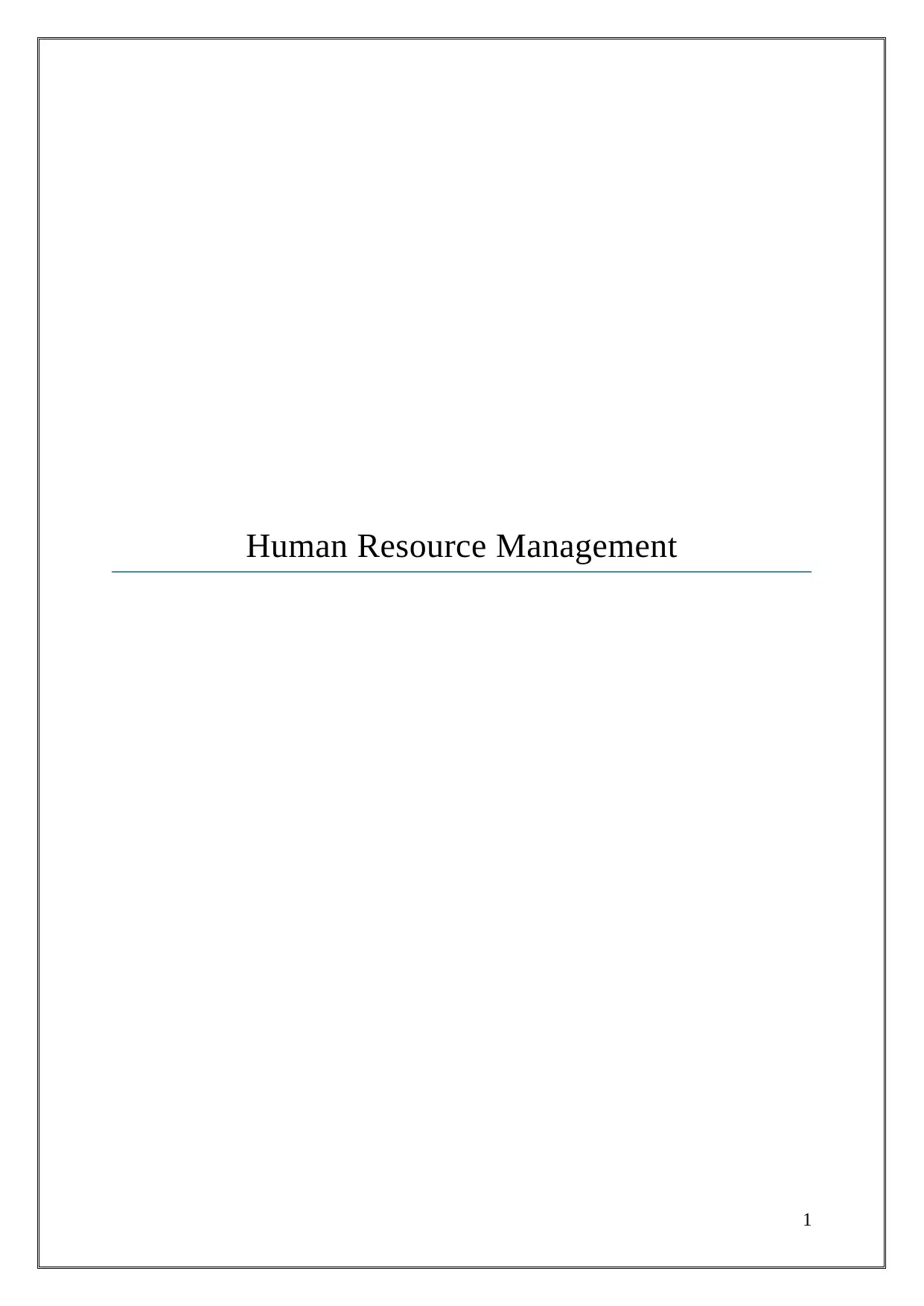
Human Resource Management
1
1
Paraphrase This Document
Need a fresh take? Get an instant paraphrase of this document with our AI Paraphraser
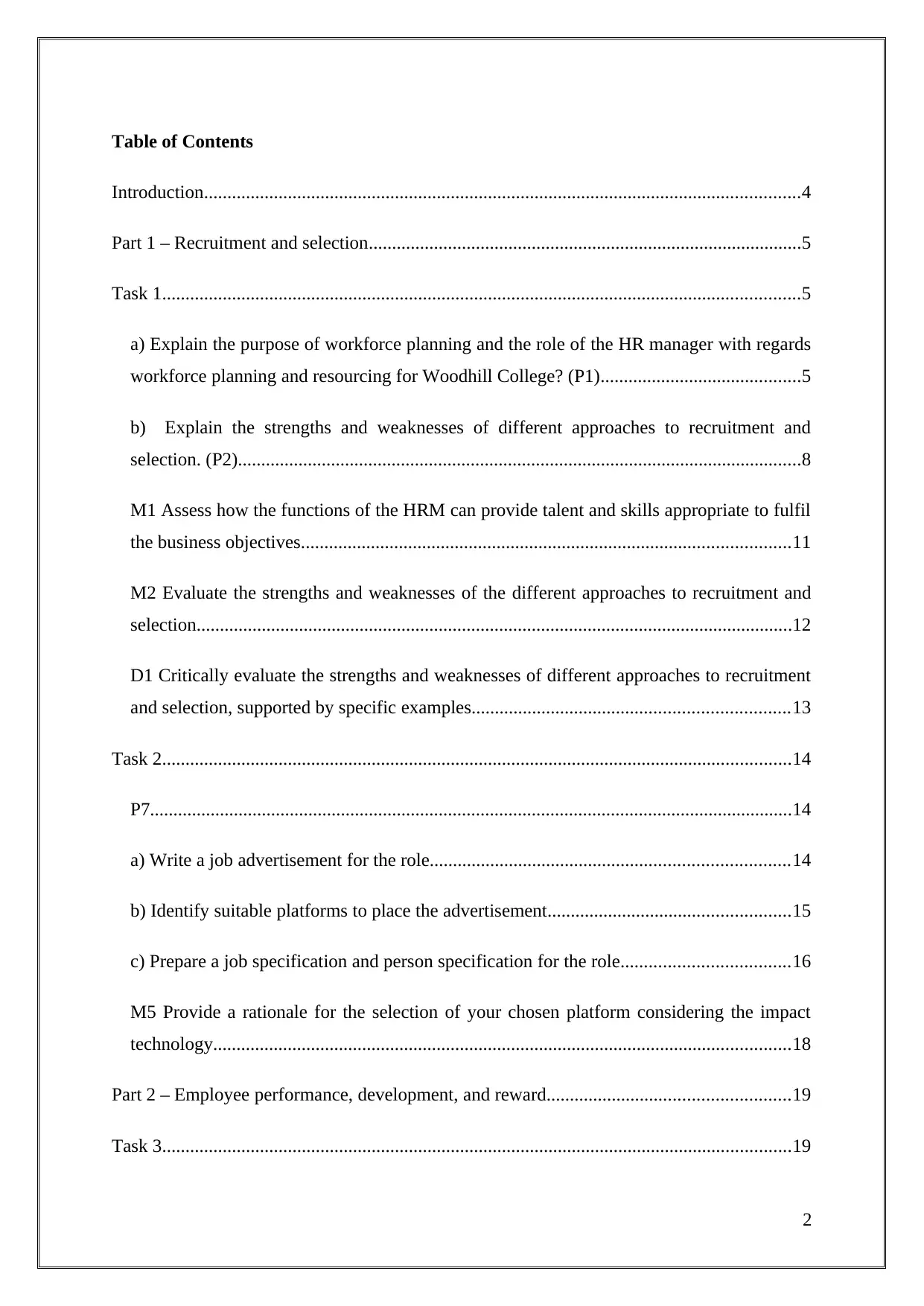
Table of Contents
Introduction................................................................................................................................4
Part 1 – Recruitment and selection.............................................................................................5
Task 1.........................................................................................................................................5
a) Explain the purpose of workforce planning and the role of the HR manager with regards
workforce planning and resourcing for Woodhill College? (P1)...........................................5
b) Explain the strengths and weaknesses of different approaches to recruitment and
selection. (P2).........................................................................................................................8
M1 Assess how the functions of the HRM can provide talent and skills appropriate to fulfil
the business objectives.........................................................................................................11
M2 Evaluate the strengths and weaknesses of the different approaches to recruitment and
selection................................................................................................................................12
D1 Critically evaluate the strengths and weaknesses of different approaches to recruitment
and selection, supported by specific examples....................................................................13
Task 2.......................................................................................................................................14
P7..........................................................................................................................................14
a) Write a job advertisement for the role.............................................................................14
b) Identify suitable platforms to place the advertisement....................................................15
c) Prepare a job specification and person specification for the role....................................16
M5 Provide a rationale for the selection of your chosen platform considering the impact
technology............................................................................................................................18
Part 2 – Employee performance, development, and reward....................................................19
Task 3.......................................................................................................................................19
2
Introduction................................................................................................................................4
Part 1 – Recruitment and selection.............................................................................................5
Task 1.........................................................................................................................................5
a) Explain the purpose of workforce planning and the role of the HR manager with regards
workforce planning and resourcing for Woodhill College? (P1)...........................................5
b) Explain the strengths and weaknesses of different approaches to recruitment and
selection. (P2).........................................................................................................................8
M1 Assess how the functions of the HRM can provide talent and skills appropriate to fulfil
the business objectives.........................................................................................................11
M2 Evaluate the strengths and weaknesses of the different approaches to recruitment and
selection................................................................................................................................12
D1 Critically evaluate the strengths and weaknesses of different approaches to recruitment
and selection, supported by specific examples....................................................................13
Task 2.......................................................................................................................................14
P7..........................................................................................................................................14
a) Write a job advertisement for the role.............................................................................14
b) Identify suitable platforms to place the advertisement....................................................15
c) Prepare a job specification and person specification for the role....................................16
M5 Provide a rationale for the selection of your chosen platform considering the impact
technology............................................................................................................................18
Part 2 – Employee performance, development, and reward....................................................19
Task 3.......................................................................................................................................19
2
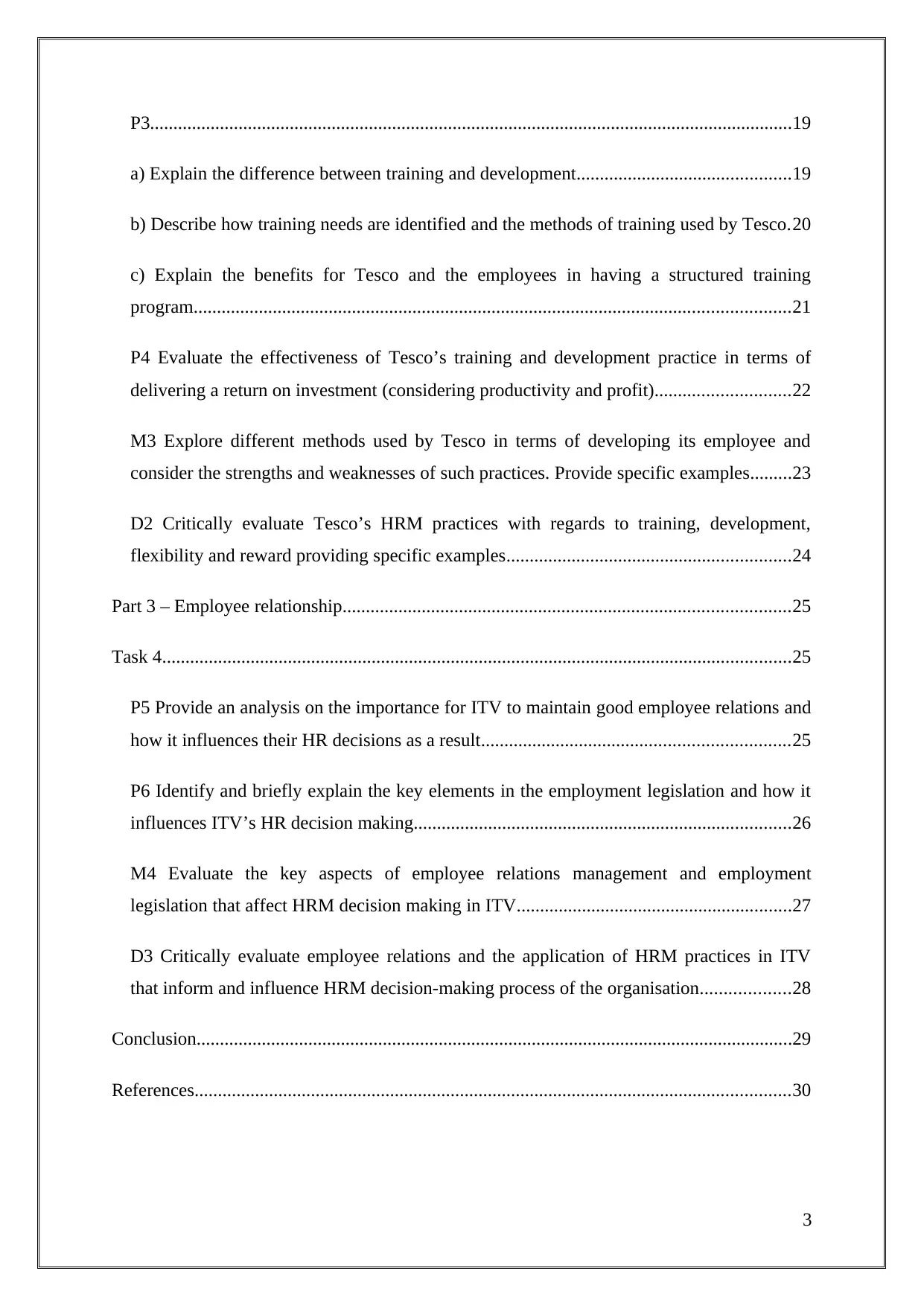
P3..........................................................................................................................................19
a) Explain the difference between training and development..............................................19
b) Describe how training needs are identified and the methods of training used by Tesco.20
c) Explain the benefits for Tesco and the employees in having a structured training
program................................................................................................................................21
P4 Evaluate the effectiveness of Tesco’s training and development practice in terms of
delivering a return on investment (considering productivity and profit).............................22
M3 Explore different methods used by Tesco in terms of developing its employee and
consider the strengths and weaknesses of such practices. Provide specific examples.........23
D2 Critically evaluate Tesco’s HRM practices with regards to training, development,
flexibility and reward providing specific examples.............................................................24
Part 3 – Employee relationship................................................................................................25
Task 4.......................................................................................................................................25
P5 Provide an analysis on the importance for ITV to maintain good employee relations and
how it influences their HR decisions as a result..................................................................25
P6 Identify and briefly explain the key elements in the employment legislation and how it
influences ITV’s HR decision making.................................................................................26
M4 Evaluate the key aspects of employee relations management and employment
legislation that affect HRM decision making in ITV...........................................................27
D3 Critically evaluate employee relations and the application of HRM practices in ITV
that inform and influence HRM decision-making process of the organisation...................28
Conclusion................................................................................................................................29
References................................................................................................................................30
3
a) Explain the difference between training and development..............................................19
b) Describe how training needs are identified and the methods of training used by Tesco.20
c) Explain the benefits for Tesco and the employees in having a structured training
program................................................................................................................................21
P4 Evaluate the effectiveness of Tesco’s training and development practice in terms of
delivering a return on investment (considering productivity and profit).............................22
M3 Explore different methods used by Tesco in terms of developing its employee and
consider the strengths and weaknesses of such practices. Provide specific examples.........23
D2 Critically evaluate Tesco’s HRM practices with regards to training, development,
flexibility and reward providing specific examples.............................................................24
Part 3 – Employee relationship................................................................................................25
Task 4.......................................................................................................................................25
P5 Provide an analysis on the importance for ITV to maintain good employee relations and
how it influences their HR decisions as a result..................................................................25
P6 Identify and briefly explain the key elements in the employment legislation and how it
influences ITV’s HR decision making.................................................................................26
M4 Evaluate the key aspects of employee relations management and employment
legislation that affect HRM decision making in ITV...........................................................27
D3 Critically evaluate employee relations and the application of HRM practices in ITV
that inform and influence HRM decision-making process of the organisation...................28
Conclusion................................................................................................................................29
References................................................................................................................................30
3
⊘ This is a preview!⊘
Do you want full access?
Subscribe today to unlock all pages.

Trusted by 1+ million students worldwide

4
Paraphrase This Document
Need a fresh take? Get an instant paraphrase of this document with our AI Paraphraser
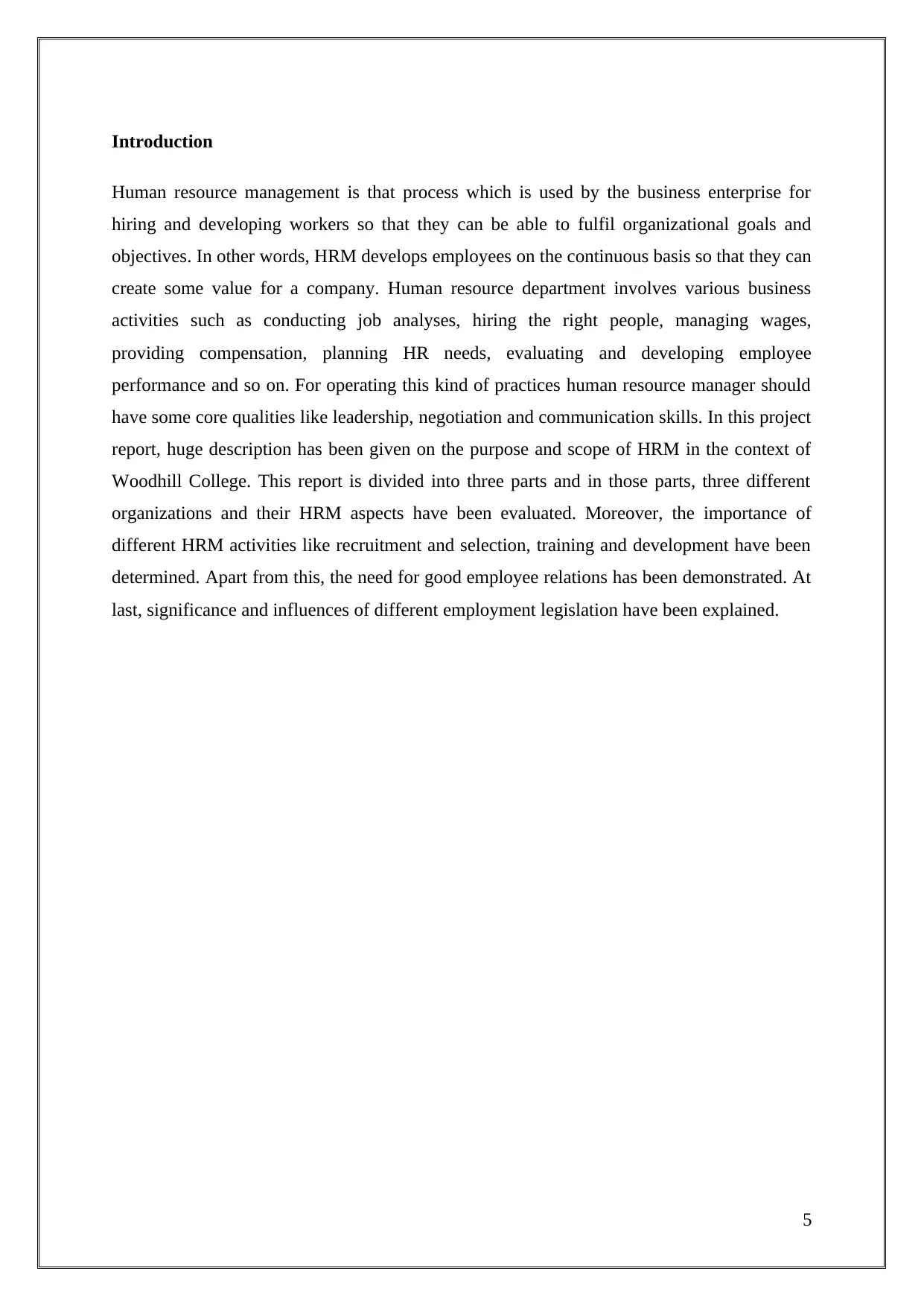
Introduction
Human resource management is that process which is used by the business enterprise for
hiring and developing workers so that they can be able to fulfil organizational goals and
objectives. In other words, HRM develops employees on the continuous basis so that they can
create some value for a company. Human resource department involves various business
activities such as conducting job analyses, hiring the right people, managing wages,
providing compensation, planning HR needs, evaluating and developing employee
performance and so on. For operating this kind of practices human resource manager should
have some core qualities like leadership, negotiation and communication skills. In this project
report, huge description has been given on the purpose and scope of HRM in the context of
Woodhill College. This report is divided into three parts and in those parts, three different
organizations and their HRM aspects have been evaluated. Moreover, the importance of
different HRM activities like recruitment and selection, training and development have been
determined. Apart from this, the need for good employee relations has been demonstrated. At
last, significance and influences of different employment legislation have been explained.
5
Human resource management is that process which is used by the business enterprise for
hiring and developing workers so that they can be able to fulfil organizational goals and
objectives. In other words, HRM develops employees on the continuous basis so that they can
create some value for a company. Human resource department involves various business
activities such as conducting job analyses, hiring the right people, managing wages,
providing compensation, planning HR needs, evaluating and developing employee
performance and so on. For operating this kind of practices human resource manager should
have some core qualities like leadership, negotiation and communication skills. In this project
report, huge description has been given on the purpose and scope of HRM in the context of
Woodhill College. This report is divided into three parts and in those parts, three different
organizations and their HRM aspects have been evaluated. Moreover, the importance of
different HRM activities like recruitment and selection, training and development have been
determined. Apart from this, the need for good employee relations has been demonstrated. At
last, significance and influences of different employment legislation have been explained.
5
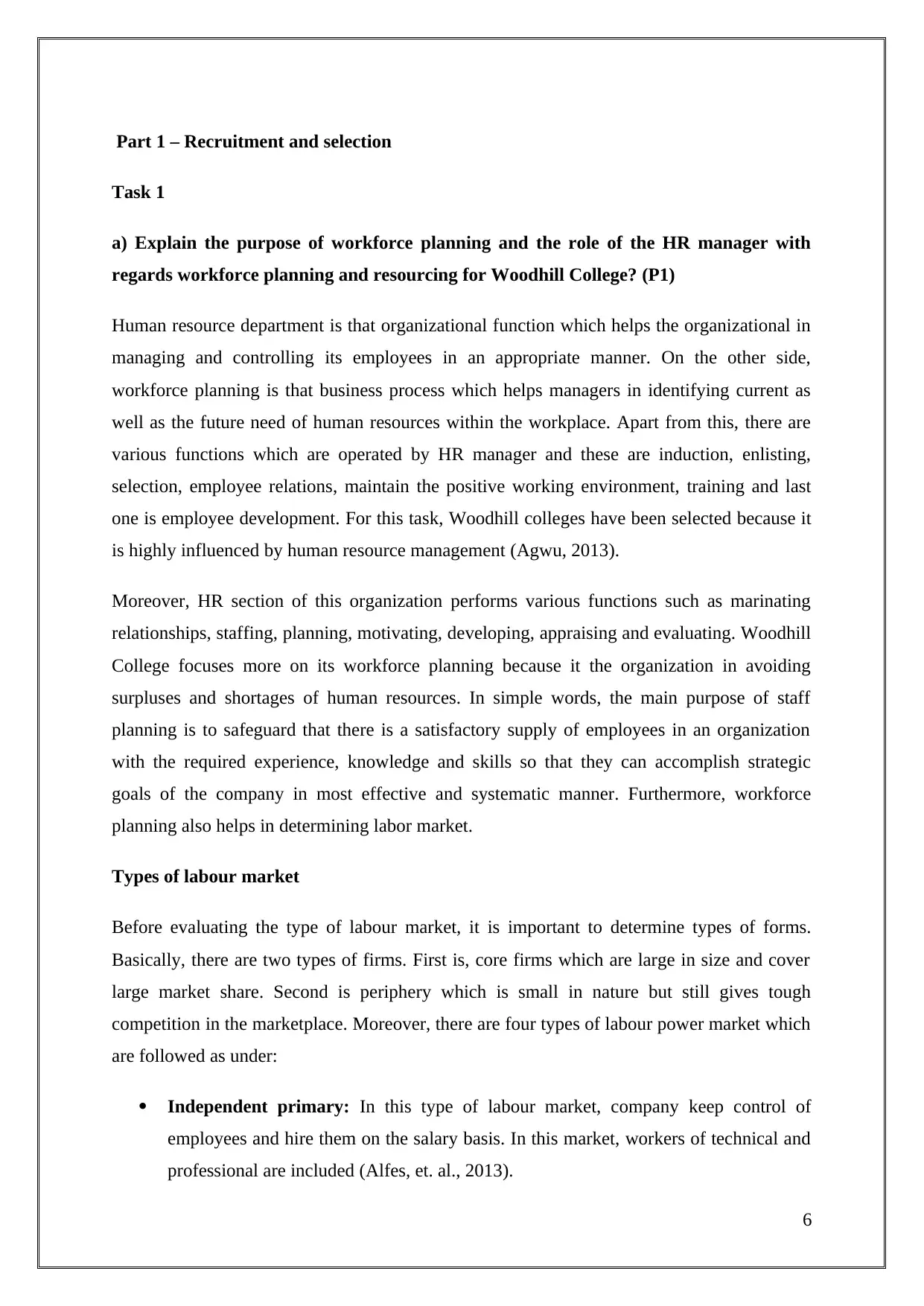
Part 1 – Recruitment and selection
Task 1
a) Explain the purpose of workforce planning and the role of the HR manager with
regards workforce planning and resourcing for Woodhill College? (P1)
Human resource department is that organizational function which helps the organizational in
managing and controlling its employees in an appropriate manner. On the other side,
workforce planning is that business process which helps managers in identifying current as
well as the future need of human resources within the workplace. Apart from this, there are
various functions which are operated by HR manager and these are induction, enlisting,
selection, employee relations, maintain the positive working environment, training and last
one is employee development. For this task, Woodhill colleges have been selected because it
is highly influenced by human resource management (Agwu, 2013).
Moreover, HR section of this organization performs various functions such as marinating
relationships, staffing, planning, motivating, developing, appraising and evaluating. Woodhill
College focuses more on its workforce planning because it the organization in avoiding
surpluses and shortages of human resources. In simple words, the main purpose of staff
planning is to safeguard that there is a satisfactory supply of employees in an organization
with the required experience, knowledge and skills so that they can accomplish strategic
goals of the company in most effective and systematic manner. Furthermore, workforce
planning also helps in determining labor market.
Types of labour market
Before evaluating the type of labour market, it is important to determine types of forms.
Basically, there are two types of firms. First is, core firms which are large in size and cover
large market share. Second is periphery which is small in nature but still gives tough
competition in the marketplace. Moreover, there are four types of labour power market which
are followed as under:
Independent primary: In this type of labour market, company keep control of
employees and hire them on the salary basis. In this market, workers of technical and
professional are included (Alfes, et. al., 2013).
6
Task 1
a) Explain the purpose of workforce planning and the role of the HR manager with
regards workforce planning and resourcing for Woodhill College? (P1)
Human resource department is that organizational function which helps the organizational in
managing and controlling its employees in an appropriate manner. On the other side,
workforce planning is that business process which helps managers in identifying current as
well as the future need of human resources within the workplace. Apart from this, there are
various functions which are operated by HR manager and these are induction, enlisting,
selection, employee relations, maintain the positive working environment, training and last
one is employee development. For this task, Woodhill colleges have been selected because it
is highly influenced by human resource management (Agwu, 2013).
Moreover, HR section of this organization performs various functions such as marinating
relationships, staffing, planning, motivating, developing, appraising and evaluating. Woodhill
College focuses more on its workforce planning because it the organization in avoiding
surpluses and shortages of human resources. In simple words, the main purpose of staff
planning is to safeguard that there is a satisfactory supply of employees in an organization
with the required experience, knowledge and skills so that they can accomplish strategic
goals of the company in most effective and systematic manner. Furthermore, workforce
planning also helps in determining labor market.
Types of labour market
Before evaluating the type of labour market, it is important to determine types of forms.
Basically, there are two types of firms. First is, core firms which are large in size and cover
large market share. Second is periphery which is small in nature but still gives tough
competition in the marketplace. Moreover, there are four types of labour power market which
are followed as under:
Independent primary: In this type of labour market, company keep control of
employees and hire them on the salary basis. In this market, workers of technical and
professional are included (Alfes, et. al., 2013).
6
⊘ This is a preview!⊘
Do you want full access?
Subscribe today to unlock all pages.

Trusted by 1+ million students worldwide
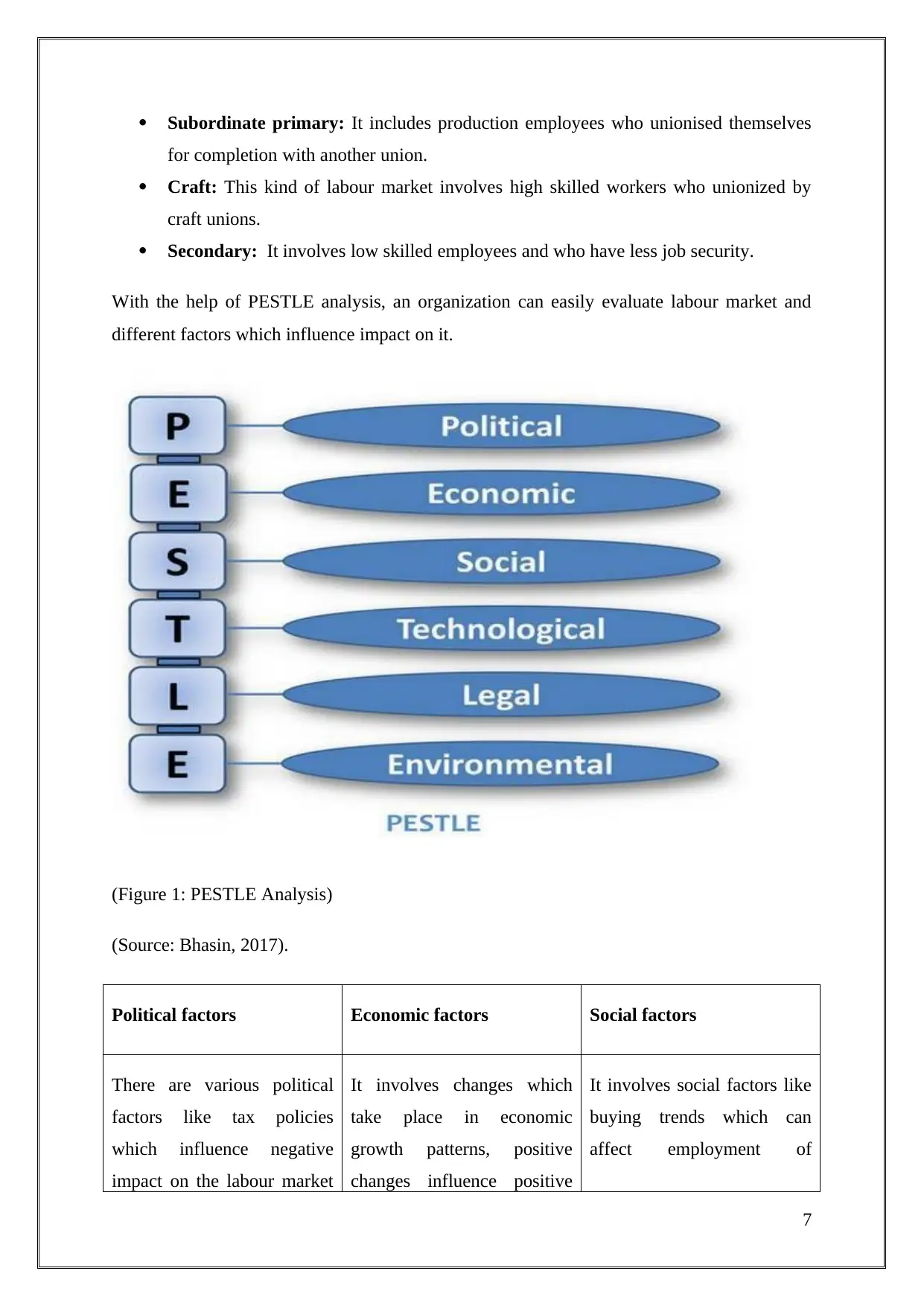
Subordinate primary: It includes production employees who unionised themselves
for completion with another union.
Craft: This kind of labour market involves high skilled workers who unionized by
craft unions.
Secondary: It involves low skilled employees and who have less job security.
With the help of PESTLE analysis, an organization can easily evaluate labour market and
different factors which influence impact on it.
(Figure 1: PESTLE Analysis)
(Source: Bhasin, 2017).
Political factors Economic factors Social factors
There are various political
factors like tax policies
which influence negative
impact on the labour market
It involves changes which
take place in economic
growth patterns, positive
changes influence positive
It involves social factors like
buying trends which can
affect employment of
7
for completion with another union.
Craft: This kind of labour market involves high skilled workers who unionized by
craft unions.
Secondary: It involves low skilled employees and who have less job security.
With the help of PESTLE analysis, an organization can easily evaluate labour market and
different factors which influence impact on it.
(Figure 1: PESTLE Analysis)
(Source: Bhasin, 2017).
Political factors Economic factors Social factors
There are various political
factors like tax policies
which influence negative
impact on the labour market
It involves changes which
take place in economic
growth patterns, positive
changes influence positive
It involves social factors like
buying trends which can
affect employment of
7
Paraphrase This Document
Need a fresh take? Get an instant paraphrase of this document with our AI Paraphraser
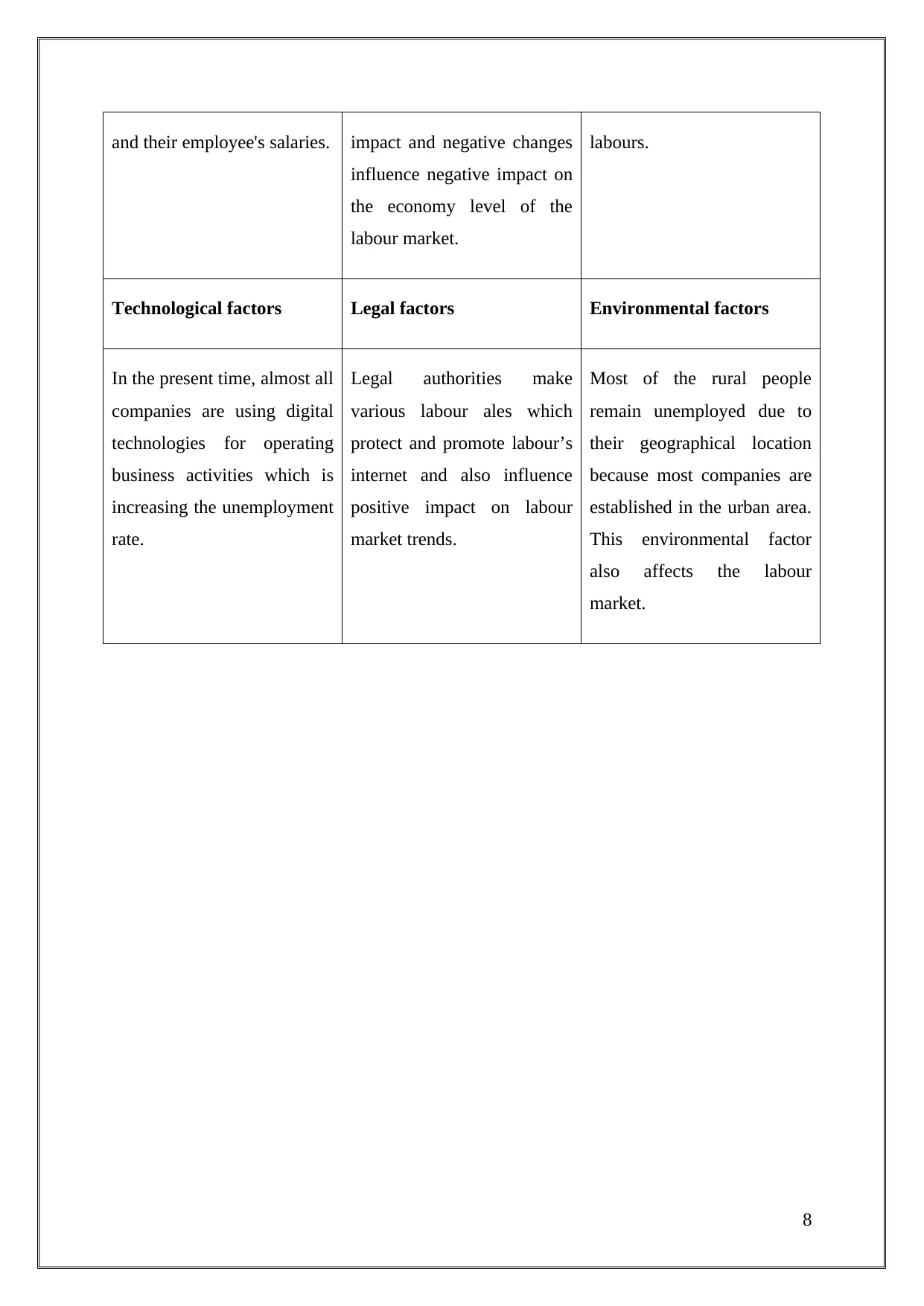
and their employee's salaries. impact and negative changes
influence negative impact on
the economy level of the
labour market.
labours.
Technological factors Legal factors Environmental factors
In the present time, almost all
companies are using digital
technologies for operating
business activities which is
increasing the unemployment
rate.
Legal authorities make
various labour ales which
protect and promote labour’s
internet and also influence
positive impact on labour
market trends.
Most of the rural people
remain unemployed due to
their geographical location
because most companies are
established in the urban area.
This environmental factor
also affects the labour
market.
8
influence negative impact on
the economy level of the
labour market.
labours.
Technological factors Legal factors Environmental factors
In the present time, almost all
companies are using digital
technologies for operating
business activities which is
increasing the unemployment
rate.
Legal authorities make
various labour ales which
protect and promote labour’s
internet and also influence
positive impact on labour
market trends.
Most of the rural people
remain unemployed due to
their geographical location
because most companies are
established in the urban area.
This environmental factor
also affects the labour
market.
8
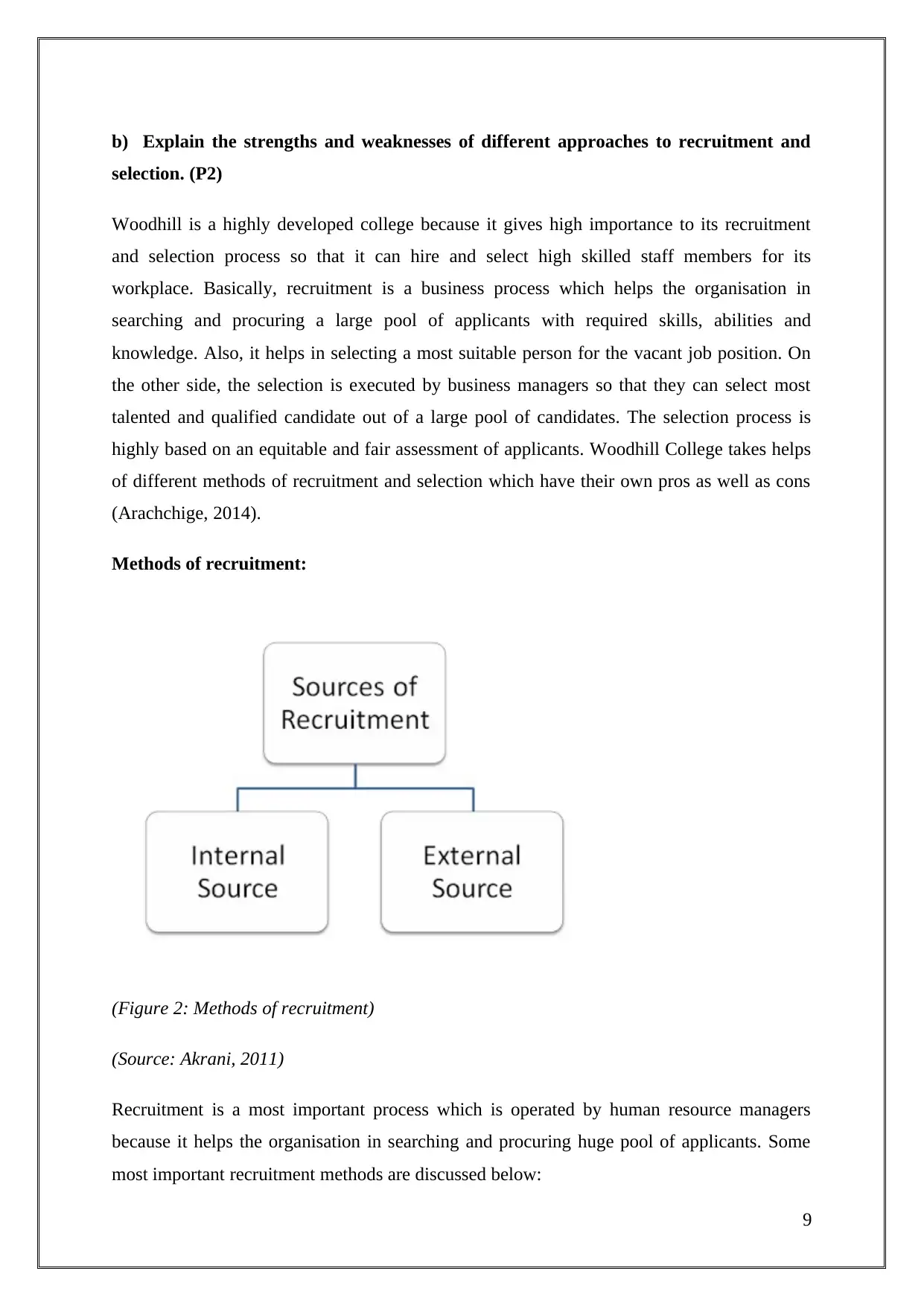
b) Explain the strengths and weaknesses of different approaches to recruitment and
selection. (P2)
Woodhill is a highly developed college because it gives high importance to its recruitment
and selection process so that it can hire and select high skilled staff members for its
workplace. Basically, recruitment is a business process which helps the organisation in
searching and procuring a large pool of applicants with required skills, abilities and
knowledge. Also, it helps in selecting a most suitable person for the vacant job position. On
the other side, the selection is executed by business managers so that they can select most
talented and qualified candidate out of a large pool of candidates. The selection process is
highly based on an equitable and fair assessment of applicants. Woodhill College takes helps
of different methods of recruitment and selection which have their own pros as well as cons
(Arachchige, 2014).
Methods of recruitment:
(Figure 2: Methods of recruitment)
(Source: Akrani, 2011)
Recruitment is a most important process which is operated by human resource managers
because it helps the organisation in searching and procuring huge pool of applicants. Some
most important recruitment methods are discussed below:
9
selection. (P2)
Woodhill is a highly developed college because it gives high importance to its recruitment
and selection process so that it can hire and select high skilled staff members for its
workplace. Basically, recruitment is a business process which helps the organisation in
searching and procuring a large pool of applicants with required skills, abilities and
knowledge. Also, it helps in selecting a most suitable person for the vacant job position. On
the other side, the selection is executed by business managers so that they can select most
talented and qualified candidate out of a large pool of candidates. The selection process is
highly based on an equitable and fair assessment of applicants. Woodhill College takes helps
of different methods of recruitment and selection which have their own pros as well as cons
(Arachchige, 2014).
Methods of recruitment:
(Figure 2: Methods of recruitment)
(Source: Akrani, 2011)
Recruitment is a most important process which is operated by human resource managers
because it helps the organisation in searching and procuring huge pool of applicants. Some
most important recruitment methods are discussed below:
9
⊘ This is a preview!⊘
Do you want full access?
Subscribe today to unlock all pages.

Trusted by 1+ million students worldwide
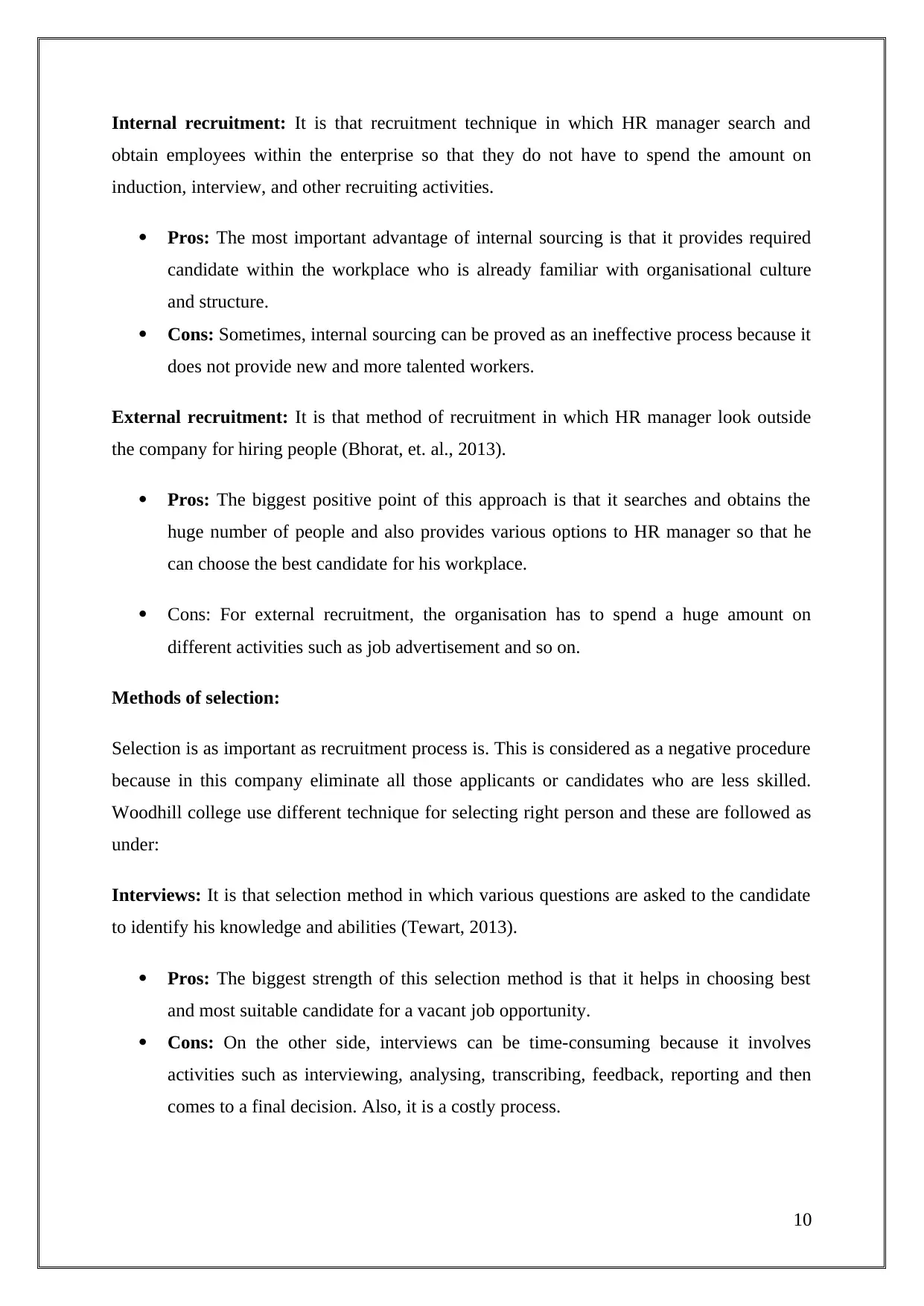
Internal recruitment: It is that recruitment technique in which HR manager search and
obtain employees within the enterprise so that they do not have to spend the amount on
induction, interview, and other recruiting activities.
Pros: The most important advantage of internal sourcing is that it provides required
candidate within the workplace who is already familiar with organisational culture
and structure.
Cons: Sometimes, internal sourcing can be proved as an ineffective process because it
does not provide new and more talented workers.
External recruitment: It is that method of recruitment in which HR manager look outside
the company for hiring people (Bhorat, et. al., 2013).
Pros: The biggest positive point of this approach is that it searches and obtains the
huge number of people and also provides various options to HR manager so that he
can choose the best candidate for his workplace.
Cons: For external recruitment, the organisation has to spend a huge amount on
different activities such as job advertisement and so on.
Methods of selection:
Selection is as important as recruitment process is. This is considered as a negative procedure
because in this company eliminate all those applicants or candidates who are less skilled.
Woodhill college use different technique for selecting right person and these are followed as
under:
Interviews: It is that selection method in which various questions are asked to the candidate
to identify his knowledge and abilities (Tewart, 2013).
Pros: The biggest strength of this selection method is that it helps in choosing best
and most suitable candidate for a vacant job opportunity.
Cons: On the other side, interviews can be time-consuming because it involves
activities such as interviewing, analysing, transcribing, feedback, reporting and then
comes to a final decision. Also, it is a costly process.
10
obtain employees within the enterprise so that they do not have to spend the amount on
induction, interview, and other recruiting activities.
Pros: The most important advantage of internal sourcing is that it provides required
candidate within the workplace who is already familiar with organisational culture
and structure.
Cons: Sometimes, internal sourcing can be proved as an ineffective process because it
does not provide new and more talented workers.
External recruitment: It is that method of recruitment in which HR manager look outside
the company for hiring people (Bhorat, et. al., 2013).
Pros: The biggest positive point of this approach is that it searches and obtains the
huge number of people and also provides various options to HR manager so that he
can choose the best candidate for his workplace.
Cons: For external recruitment, the organisation has to spend a huge amount on
different activities such as job advertisement and so on.
Methods of selection:
Selection is as important as recruitment process is. This is considered as a negative procedure
because in this company eliminate all those applicants or candidates who are less skilled.
Woodhill college use different technique for selecting right person and these are followed as
under:
Interviews: It is that selection method in which various questions are asked to the candidate
to identify his knowledge and abilities (Tewart, 2013).
Pros: The biggest strength of this selection method is that it helps in choosing best
and most suitable candidate for a vacant job opportunity.
Cons: On the other side, interviews can be time-consuming because it involves
activities such as interviewing, analysing, transcribing, feedback, reporting and then
comes to a final decision. Also, it is a costly process.
10
Paraphrase This Document
Need a fresh take? Get an instant paraphrase of this document with our AI Paraphraser
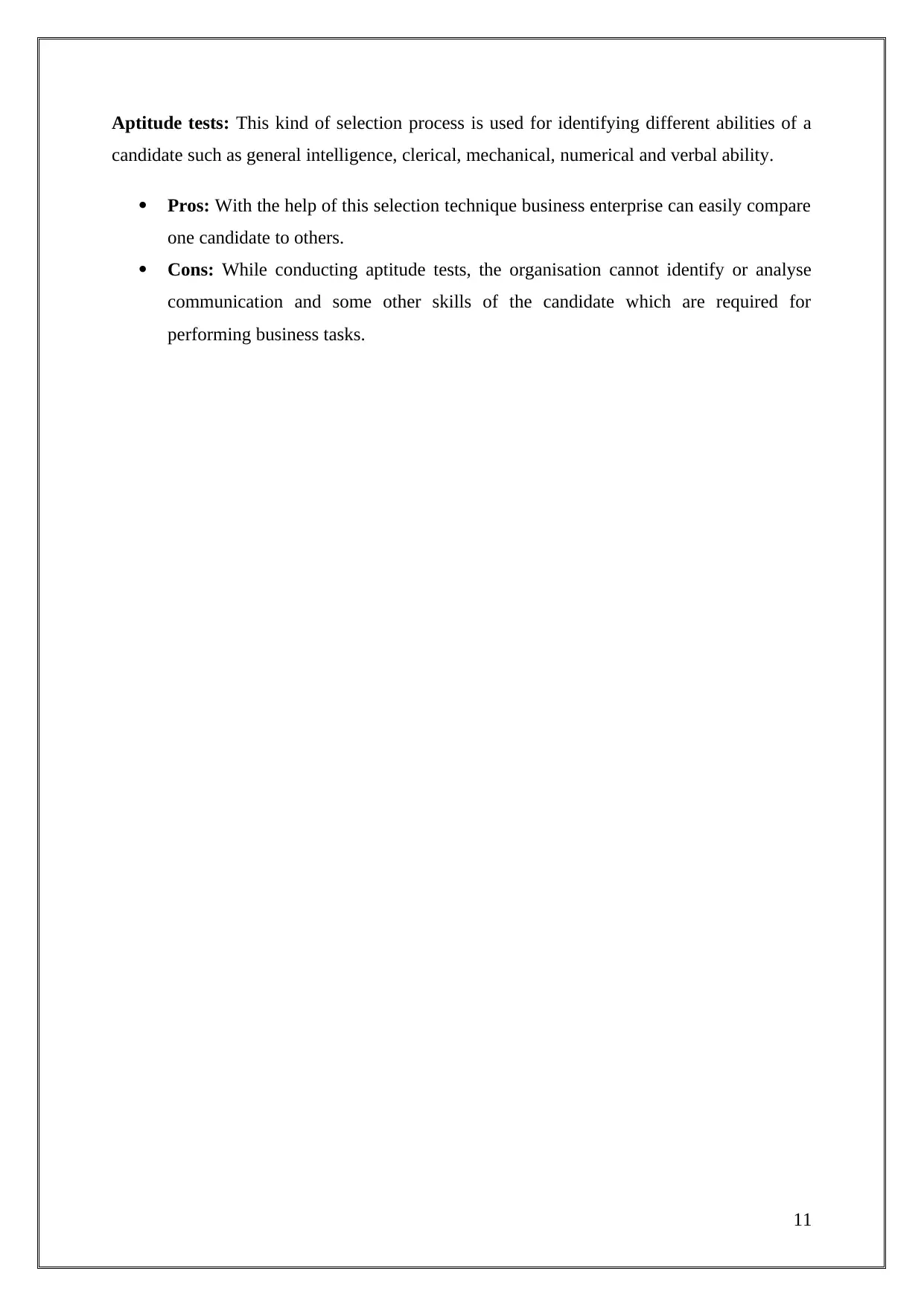
Aptitude tests: This kind of selection process is used for identifying different abilities of a
candidate such as general intelligence, clerical, mechanical, numerical and verbal ability.
Pros: With the help of this selection technique business enterprise can easily compare
one candidate to others.
Cons: While conducting aptitude tests, the organisation cannot identify or analyse
communication and some other skills of the candidate which are required for
performing business tasks.
11
candidate such as general intelligence, clerical, mechanical, numerical and verbal ability.
Pros: With the help of this selection technique business enterprise can easily compare
one candidate to others.
Cons: While conducting aptitude tests, the organisation cannot identify or analyse
communication and some other skills of the candidate which are required for
performing business tasks.
11
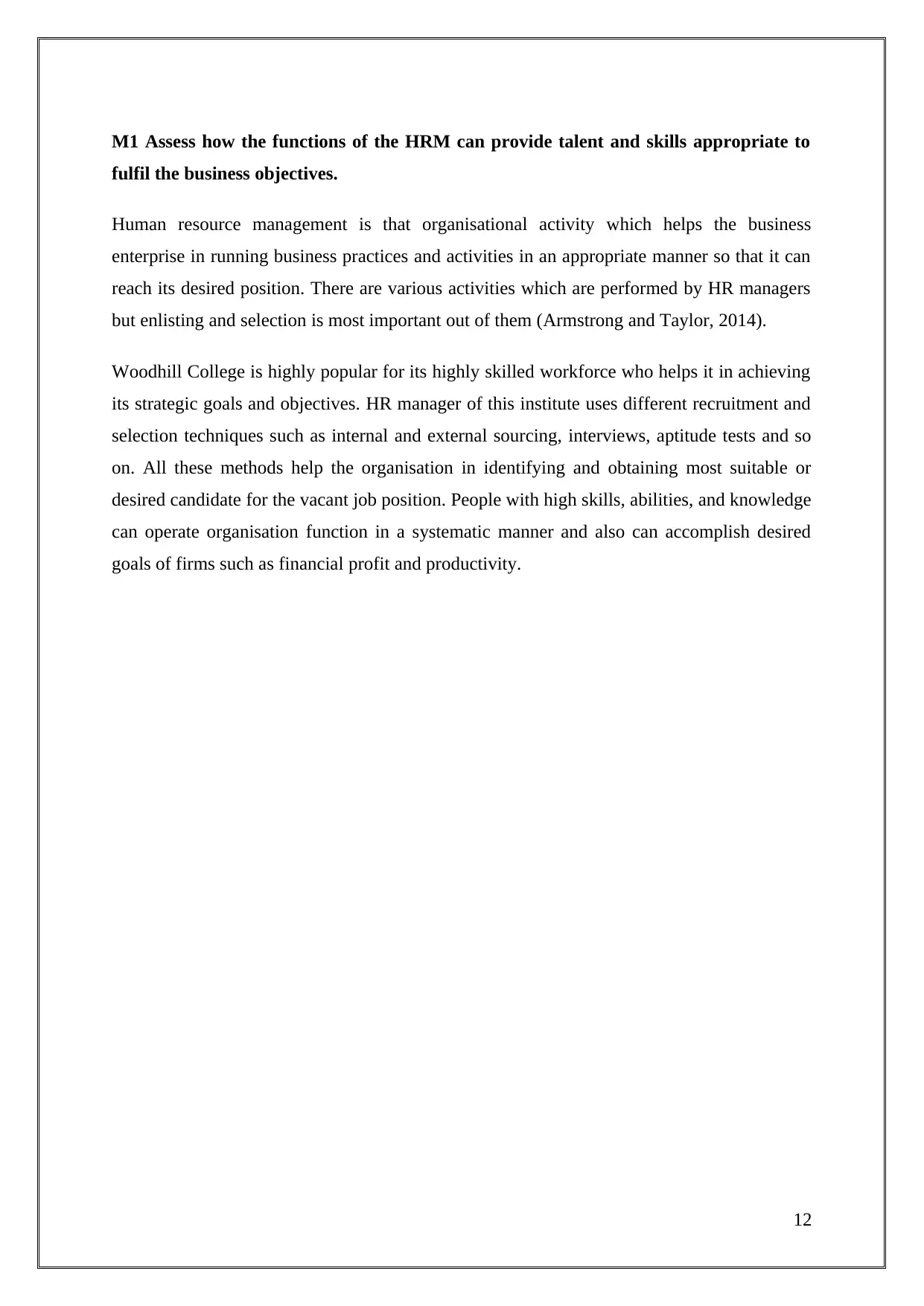
M1 Assess how the functions of the HRM can provide talent and skills appropriate to
fulfil the business objectives.
Human resource management is that organisational activity which helps the business
enterprise in running business practices and activities in an appropriate manner so that it can
reach its desired position. There are various activities which are performed by HR managers
but enlisting and selection is most important out of them (Armstrong and Taylor, 2014).
Woodhill College is highly popular for its highly skilled workforce who helps it in achieving
its strategic goals and objectives. HR manager of this institute uses different recruitment and
selection techniques such as internal and external sourcing, interviews, aptitude tests and so
on. All these methods help the organisation in identifying and obtaining most suitable or
desired candidate for the vacant job position. People with high skills, abilities, and knowledge
can operate organisation function in a systematic manner and also can accomplish desired
goals of firms such as financial profit and productivity.
12
fulfil the business objectives.
Human resource management is that organisational activity which helps the business
enterprise in running business practices and activities in an appropriate manner so that it can
reach its desired position. There are various activities which are performed by HR managers
but enlisting and selection is most important out of them (Armstrong and Taylor, 2014).
Woodhill College is highly popular for its highly skilled workforce who helps it in achieving
its strategic goals and objectives. HR manager of this institute uses different recruitment and
selection techniques such as internal and external sourcing, interviews, aptitude tests and so
on. All these methods help the organisation in identifying and obtaining most suitable or
desired candidate for the vacant job position. People with high skills, abilities, and knowledge
can operate organisation function in a systematic manner and also can accomplish desired
goals of firms such as financial profit and productivity.
12
⊘ This is a preview!⊘
Do you want full access?
Subscribe today to unlock all pages.

Trusted by 1+ million students worldwide
1 out of 32
Related Documents
Your All-in-One AI-Powered Toolkit for Academic Success.
+13062052269
info@desklib.com
Available 24*7 on WhatsApp / Email
![[object Object]](/_next/static/media/star-bottom.7253800d.svg)
Unlock your academic potential
Copyright © 2020–2025 A2Z Services. All Rights Reserved. Developed and managed by ZUCOL.





